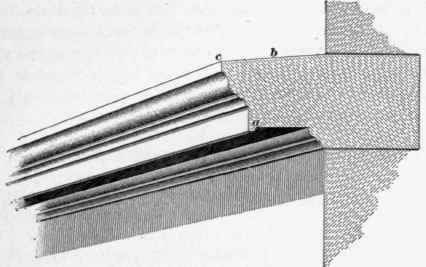Trimmings
Description
This section is from the book "A Treatise On Architecture And Building Construction Vol2: Masonry. Carpentry. Joinery", by The Colliery Engineer Co. Also available from Amazon: A Treatise On Architecture And Building Construction.
Trimmings
69. The term trimmings, as generally used, includes moldings, belt courses, sills, caps, and other cut stone (except ashlar) used for ornamental purposes.
The stones for such work should be of good quality, having the beds closely dressed and the ends square and properly matched. The faces may be pitched off, but all washes, soffits, etc. should be cut or rubbed. When a brick building is trimmed with stone, great care should be taken to have the trimmings set properly, without having to split the courses of brick below or above; such a procedure would spoil the appearance of the building.
70. Washes And Drips
Washes And Drips. The tops of all cornices, belt courses, etc. should have an outward pitch from the walls, as shown at b, Fig. 34. If the top is level or slopes inwardly, rain will collect, and in time will cause the disintegration of the mortar in the adjacent joints, and will finally penetrate the wall. The beveled surfaces are called washes. On the under side of the cornices, etc., drips should be made, to prevent rain from flowing down the faces of the walls. At a, Fig. 34, is shown the drip; at b, the wash of the cornice; and at c, the stone cut to a sharp angle, to shed part of the water from that edge.

Fig. 34.
Window sills should also have a drip cut in them, as shown at a, Fig. 35, to keep the walls below from becoming discolored by dirt washed off the sills by rain.

Fig. 35.
Continue to:


